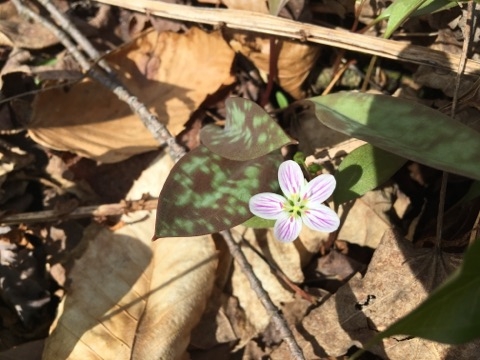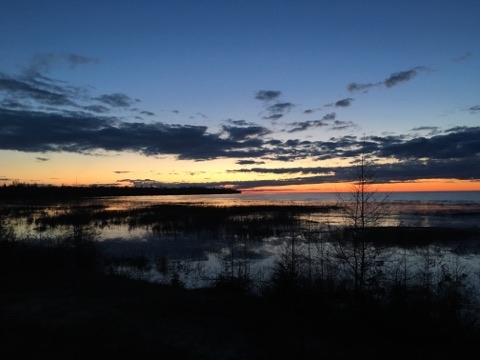5/9: Very odd morning, with a lot of species on the move, but mostly in small numbers, variable directions, and with several putting on the disappearing act after loafing for a while. Spotted sandpipers, of all things, were the heavy hitters today, with a minimum of 30 flying East, and often ditching out briefly on McGulpin Rock due to the strong winds and driving rain. With them were six killdeer, a mystery flock of passerines that looked a bit like phoebes, and another mystery passerine that could have been a robin. Two tree swallows also flying East, two common terns (alone, and separated by four hours) also headed East, and a lone Bonaparte’s headed West. Waterfowl were thin on the water, with a single loafing loon and horned grebe, and depressed numbers of red-breasted merg and long-tail (which themselves appeared to be headed East in scattered numbers). Lone greater scaup and small bufflehead flock flew in to loaf, but then disappeared. Single great blue heron also battling the winds Eastward, eventually flying around towards Mackinaw City.
eBird list: https://ebird.org/view/checklist/S56050641
It became a particularly odd afternoon as well, as on a short trip around the Headlands trails before the evening count, I came across an American bittern in the middle of the woods. No joke—it flushed from the trail beside a tiny mud puddle in the open oak/beech forest at the top of the hill; no doubt a fallout migrant caught up in the rain and dumped out by the descending fog in mid-afternoon. By far the weirdest place I’ve ever found one. FOY blackburnian warbler in a small foraging flock, and finally an abundance of spring ephemerals! Mostly trout lily and hepatica in the lower gallery forest, but a carpet of wild ramps at the top of the hill, with scattered squirrel corn, trillium, and ostrich fern fiddleheads. Only the hepatica were fully in bloom.
Evening count was misty and dour, but produced some good highlights. Roving flock of yellow-rumped and palm warblers passed West, a Caspian tern was present throughout the count, and snipe, bitterns, sora, Virginia rail, and pied-billed grebes were calling. Further out, a large flock of mainly tree swallows was swirling about in the fog, and included at least two barn swallows. Once again no tricolored (it doesn’t seem to show on days of inclement weather), but a great blue and a great egret showed well. Solitary sandpiper heard migrating Eastward right at the end of the count, and a pair of barred owls was calling back up in the swamp near the North Country Trail.
eBird list: https://ebird.org/view/checklist/S56068650

5/10: MASSIVE morning! Strong NW wind had whipped the lake into a frenzy, but was in just the right direction to release a torrent of migrants that had been backed up further South in Lake Huron. Big numbers of white-winged scoter (147, including large flocks of 16, 21, and 29), red-breasted merg (231), and long-tail (170), and a late surge of greater scaup (65, including one flock of 52). Common loons, horned grebes, and red-necked grebes continued to stream through (though in lower numbers than in previous weeks), but were joined by four red-throated loons, which finally showed well enough for me to call the ID (FOY were probably sometime this week, but logged as “loon sp.” due to poor viewing conditions, etc.). Other notable birds included a close-passing male black scoter (FOY) with a small white-winged scoter group, a pair of North-flying great blue herons, and a late-ish goldeneye pair. Good gull diversity, but small numbers, with three Bonaparte’s, one Caspian, and four Common terns beyond the usual ring-bills and herrings.
The biggest surprise of the day, however, was the passage of a highly unusual but expected (Kevin has been saying I’ll get one all spring!) maritime migrant—a parasitic/pomarine jaeger! The bird was between 0.5 and 0.75 miles off-shore, and was seen for about a minute flying NW. Currently in conversation with Adam Byrne, the regional reviewer, about how whether this bird is reportable to species level, but my initial impression was parasitic, and I’m still leaning that way (see eBird list for more lengthy discussion).
eBird list: https://ebird.org/view/checklist/S56106448

Comparatively quiet evening count, with Northerly winds stirring the marsh and keeping most birds quiet. Still a few buffleheads hanging about.
eBird list: https://ebird.org/view/checklist/S56080920
5/11: Pretty lackadaisical morning, with red-breasteds and long-tails loafing once more on glassy waters. A single passing red-throated loon was a nice highlight mid-morning, and I also picked out a tight raft of horned grebes off to the West, two of which were engaged in the beginnings of a breeding dance, which I’d never seen in person before. Lots of passerine stirrings in the woods behind the count, with the first Northern parula of the year, along with plentiful yellow-rumpeds, a few black-throated greens, a black-and-white, and a palm warbler.
eBird list: https://ebird.org/view/checklist/S56122178
Well, that does it for my time in Mackinaw! It’s been an exciting and rewarding season, and our intrepid avian adventurers have done their best to bring life back to the forests and marshes despite the late cold. Thanks to all the people involved with this organization and visiting along the way who made this a unique and truly memorable experience!

